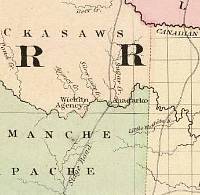
Wichita Agency area, 1874 map by
Asher and Adams. Courtesy David Rumsey Map Collection.
Click images to enlarge
|
|
In 1859 official representatives of the United
States presented Caddo chiefs and headmen with the Arbuckle
Agreement that assured Caddos they would occupy a country
belonging to the United States, and not within any State,
where none could intrude upon them; and they would remain,
they and their children, as long as the waters should run,
protected from all harm by the United States. The Superintendent
of Indian Affairs defined boundaries for that country that
were adequate. The certain promise of permanency and protection
satisfied the Caddos' greatest need. In accord with the agents
for the United States government, the chiefs and headmen accepted
the Arbuckle Agreement on July 1, 1859. Upheaval created by
the Civil War soon canceled the Agreement's certainty.
During the white man's war most Caddos spent
five debilitating years as refugees in Kansas. Others sought
protection with the Seminole Nation or at Whitebead Hill in
the Chickasaw Nation. It was 1867 before all returned, only
to find their houses ruined, fields and fences destroyed,
livestock stolen and large sections of their assigned territory
taken away. Houses could be rebuilt, fields replanted, and
new livestock raised, but it was not possible to gain self-sufficiency
through farming, hunting, and trade without the security of
a permanent location with adequate acreage.
Even as the main body of Caddos were returning
to their Washita River valley home sites, U. S. agents were
negotiating a peace treaty that gave the southern half of
the Leased District to warring Comanches and Kiowas. The treaty
ignored the Arbuckle Agreement that assigned all of the land
from the Chickasaw line to the 100th meridian and from Red
River to the Canadian River to peaceable Caddo, Wichita, and
affiliated tribes. The Agreement was ignored again in 1869
when an Executive Order located Cheyennes and Arapahoes on
a tract overlapping Caddo territory below the Canadian River.
Caddo leaders defended their land boundaries
as best they could. They held Council with Agents, pooled
their meager funds, sent representatives with interpreters
to plead their case at the nation's capitol. But, the last
years of the 19th Century passed without a secure land title.
During that time, much was learned about coexistence in a
world dominated by Americans endowed with skills yet to be
acquired by Caddo people.
Jose Maria, Iesh, the Anadarko whose
balanced leadership and wisdom guided Caddos, Hainais, and
Anadarkos during turbulent years in Texas, died before the
end of the Civil War. Guadelupe, Nah-ah-sah-nah, was
the accepted leader following the Civil War. Born in 1825
near Natchitoches, Louisiana, he died in 1877. Caddo George
Washington (Sho-ee-tat), the recognized leader of the Whitebead
Caddos before, during, and after the Civil War, died in 1883.
In 1865 Indians from all of Indian Territory
gathered for a Peace Council held in an area on the Washita
River that covered the entire present city of Verden, Oklahoma.
Disorder and uncertainty had ruled the Territory since the
beginning of the Civil War. The grantees of protection by
the Federal Government was withheld. The Confederate Government
made elaborate offers of protection that seemed, in the beginning,
a better chance for the Indians to maintain their existence.
Indian leaders soon learned that Confederate promises were
never more than spoken words, real protection did not exist.
Errant Plains Indian bands and Texas bandits drove off herds
of Indian cattle and horses without hindrance. The white man's
war created dissension among some tribes. There was fear that
the Plains Indians would go on the war path against settled,
agricultural tribes. Indian leaders realized that inter-tribal
unity was imperative if they wanted to survive.
The 1865 Peace Council was called to organize
an Indian league. A compact was signed by George Washington,
Tiner, and two other delegates from the Reserve Caddo Nation.
It was also signed by delegates from the Five Civilized Tribes
in the eastern Territory, Osages from the north, Delawares,
and the Kiowas, Comanches, Apaches, Cheyennes and Arapahoes
(called the Plains Indians from the west). Texas officials,
who had considered the possibility of an alliance with all
the Indians in order to help Texas protect her frontier, sent
representatives but they played no part in the council.The
compact incorporated a motto--the great principal of Confederate
Indian tribes-- "An Indian shall not spill an Indian's
blood."
As soon as federal boarding schools for Caddo
children were opened in 1870-1871, Guadelupe and Caddo George
Washington not only insisted that boys and girls attend, they
kept close tabs on their progress. Children were taught math,
geography, the reading and writing of English as well as New
Testament and Genesis lessons by members of the Society of
Friends (Quakers).
|
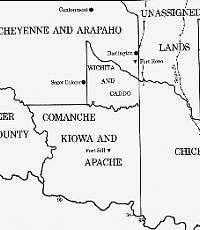
The Fort Arbuckle Agreement concluded
on July 1, 1859, set the boundaries for land within
the Leased District of Indian Territory that Caddo,
Anadarko, and Hasinai chiefs and headmen were assured
"they would remain, they and their children, as
the waters should run, protected from all harm by the
United States."
|
|
|
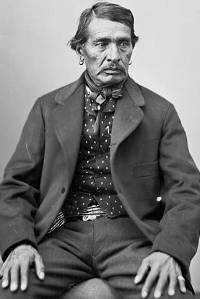
Sho-ee-tat, George Washington, was an active
leader of the Whitebead Caddo band before, during, and after
the Civil War. 1872 portrait taken when delegation visited
Washington. National Anthropological Archives..
|
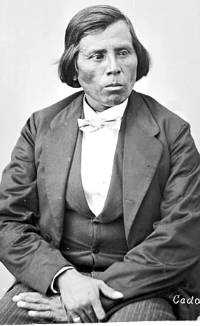
Guadelupe, Nah-ah-sah-nah,(Warloupe) was
accepted as a leader of Caddo and Hasinai communities following
the death of Iesh. 1872 portrait taken when delegation visited
Washington. National Anthropological Archives.
|
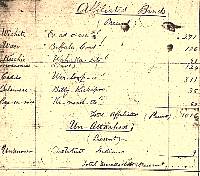
Wichita Agency rolls (census) for 1869.
Courtesy Cecile Carter.
|
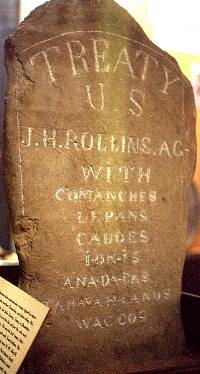
The Camp Napoleon Monument, dedicated in
1930, is located on the high school campus in Verden, Oklahoma
. It honors representative of Indian tribes who signed a compact
in 1865 to preserve the peace, happiness, and protection of
their people. The maker is due to the efforts of noted historian
and President of the Oklahoma College for Women, Dr. Anna
Lewis.
|
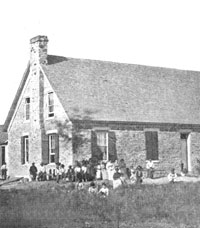
Butler School, 1871. Josiah Butler taught
Caddo children at this U.S. Indian School built in between
present Fort Sill and Lawton, Oklahoma, 1870.
|
|
| |
After the Caddo children had been in school a few weeks,
George Washington came in one evening and the next morning
he was in the school room when I got up and there he stayed
until bed time, having his meals and drink carried to him
and his team cared for by the children. After all was over,
ending with 'singing geography,' from outline maps, I left
the room. Very soon afterward I heard uproarious laughter
in the school room. This was repeated the third time, when
I slipped out and, looking in the window, found Washington
examining his children to see if they could do anything without
my being present. While he could talk English quite well,
he did not know a thing about the books, charts and maps and
so could not use the points at all, and so the children laughed
at him. He then got behind the class and made each one in
turn use the points and read and spell in English, going over
all that I had through the day and giving the meaning in Caddo.
He knew they knew no English when they came and, in this way,
he proved them as to how much they had learned, and he was
satisfied.
Josiah Butler, pioneer teacher at the Comanche-Kiowa
Agency school on the site between present Fort Sill and Lawton
1870-1873
This morning school was visited by Guadelupe, principal
chief of the Caddoes, who made a long speech to the children,
in which he told them that all white children go to school;
that they do not talk and laugh out loud—they tried hard
to learn; and he wanted them to be like the white children—mind
all their teachers tell them, and try hard to learn. He also
told them that at night they went to bed to sleep at once;
not talk and play, so as to keep all in the house awake.
Thomas C. Battey, teacher at the Wichita Agency
school, 1871
As a child his mother sent him to council meetings. He
became an interpreter and before the old chief died, he called
a council. He told him [her father] to come. Said "I
want to talk to you all and tell [you] I'm getting old. I'm
not going to be with you long. He [Enoch Hoag] should have
been in here, not me. It rightly belongs to him."
Lillie Whitehorn, 1978, daughter of Enoch Hoag,
the last of the traditional Caddo chiefs
|
|
|
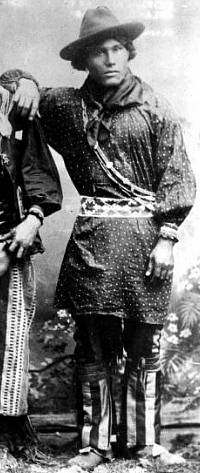
Stanley Edge, interpreter for the
last of the traditional chiefs, was sent to Carlisle
Indian school. Western History Collections, University
of Oklahoma.
|

The Riverside Indian School near Anadarko, Oklahoma, is
the oldest federal government school for Indians in continuous
operation. Photo by Steve Black. |
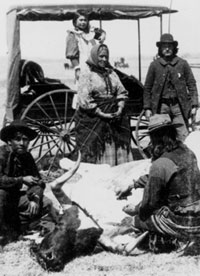
Inkanish family butchering steer
issued at Fort Still, Oklahoma in 1894. Archives and
Manuscripts Division, Oklahoma Historical Society.
|
|
Caddo elders traditionally schooled a future
caddi (cah-de, a principal leader, chief) from early
childhood. By the time he assumed his hereditary leadership
position, he was prepared with the necessary knowledge and
skills. Forward-looking leaders in 1870 viewed English language
skills as vital for the preparation of the next generation
of leaders. Their nation's most recent history warned against
blind acceptance of oral and written words that led to misunderstanding.
Every council with Americans required an interpreter; every
treaty marked with an X at the end of unreadable names had
failed to meet expectations. Some failures were the result
of hidden meanings or untranslatable English words that were
ineffectively expressed by the interpreter. Words often had
different meanings for people of different languages. There
were times when even the most trusted, competent, interpreter
was unable to transmit the nuance of a word or phrase. Many
interpreters were thought trustworthy, but Caddo interests
were not their prime concern. Wisdom demanded that future
Caddo leaders be as adept in English as well as their native
language.
George Washington died in 1883; Guadelupe in
1887. Caddo Jake, Hah-cah'-yo kee na say a ("once
lived in white house") was generally recognized as principal
chief 1890-1902). Community headmen, also hereditary leaders,
played an increasingly prominent roll in protecting and guiding
the rebuilding the nation whose culture was nearly a thousand
years older than that of the United States of America they
were compelled to accommodate.
Major communities grew, much as they always had, from a nucleus
of related families. A man who married a woman from another
community usually went to live as part of her family group.
All lived in substantial log or frame houses on farmsteads
of ten or more acres. Women kept the houses clean and tidy
and tended garden patches; men labored fencing fields, cultivating,
and raising cattle and horses. Lack of industry and effort
did not slow their progress toward self-sufficiency. Blizzards,
drought, and poor soil; a pestilence of grasshoppers and epidemics
of whooping cough, measles, and influenza; Comanche raids,
and Texas horse thieves did.
Rations distributed from the Agency staved off
the possibility of starvation and provided a vague semblance
of former days spent in hunting deer and chasing of buffalo.
The Agent made a yearly census listing the names of headmen
and the number of men, women, boys, and girls in their "band".
Headmen were appointed "beef chiefs." Traveling
ten or more miles on horseback, in wagons, or in hacks, families
arrived to set up overnight camps. Each "beef chief"
was given a ticket showing his name, the name of his band,
his number on the census roll, the number of persons in his
family, the total number of rations they were entitled to
receive at each issue, and the dates of the issues.
These tickets were turned over to the women
who were admitted in line at one door of the commissary, exited
at another. Their task was about as pleasurable as standing
in a long check out line at Super Wal-Mart. An issue clerk
stationed with an interpreter near the entrance punched out
the date on the ticket and called out something like "one
of flour, two of sugar, one soap, and one baking powder."
The women passed the sacks they brought across a counter to
an assistant clerk who filled them with the measured amount
of flour, sugar, salt, beans, rice, baking powder, and soap
to which they were entitled.
High spirits roused when the beef was issued.
The cattle were in a corral where all could see them. Clerks
recorded weights as herders ran them over scales. They then
turned them into a narrow chute that opened onto the prairie.
The issue clerk, assisted by an interpreter, called out the
names of beef chiefs and pointed out the cattle apportioned
to them. The gate was thrown open and as cattle cleared the
chute, two to ten mounted Indians fell behind each one. The
average turnout was one per minute. Boys on ponies let out
a yell and shot arrows in the flank and neck. Men raised their
revolvers or Winchesters to spurt up dust, then shot a bullet
to make the steer stagger on three legs. When the animal fell,
women rushed out to begin the butchering. Thin strips were
cut and hung to dry over camp fires.
|
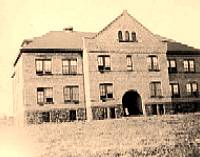
The Riverside Indian School across the Washita River
from Anadarko, Oklahoma grew from the first Wichita
Agency school that employed Tomas C. Battey as teacher
in 1871. 1899 photograph by Annette Ross Hume. Western
History Collections, University of Oklahoma. |
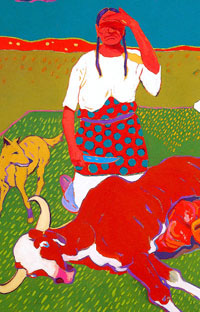
"Beef Issue at Fort Still"
painting by T.C. Cannon, son of a Kiowa father and a
Caddo mother. Courtesy of the Tee Cee Cannon Estate
and Joyce Cannon Yi, estate executor.
|
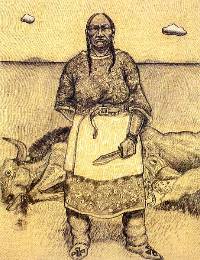
"Beef Issue, Woman Study,"
pencil drawing done T. C. Cannon in preparation of his
painting "Beef Issue at Fort Still. " Courtesy
of the Tee Cee Cannon Estate and Joyce Cannon Yi, estate
executor.
|
|
|
| |
"I do not know why it was but Caddos always loved
to camp. They'd go visiting other families and camp for two
or three days, maybe a week. Then, of course, they always
camped at dances."
Wimpy Edmonds, speaking of his grandparents
|
|
|
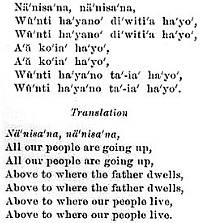
Ethnologist James Mooney who studied
the Caddo Ghost Dance in 1890-91, described this song,
"The sentiment and swinging tune of this spirited
song make it one of the favorites. It encourages the
dancers in the hope of a speedy reunion of the whole
Caddo nation, living and dead, in the "great village"
of their father above."
|
|
Camping was a favored pastime. Two or three
days, even a week of camping was usual while visiting the
homes of friends or attending a dance. Someone like the "rich
widow" Caddo Jennie would say, "I'm giving a dance"
and families from miles around would come to camp, eat, socialize,
and dance to the drum of old songs sung since time before
memory. The dances were not the dances pictured by people
who have only seen movies or gone to intertribal powwows.
They were, and still are, family affairs. Songs carrying stories
about the beginning of the Caddo people and important historical
events validate Caddo existence; frivolous songs cheer dancing
couples; morning songs greet the sun at the beginning of a
new day.
|
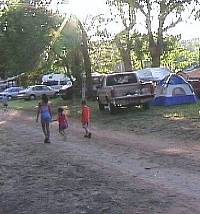
Camping is still a favored pastime for
many Caddo, especially during the summer for dances. Murrow
Dance Ground.
|
|
| |
In front of those who are dancing there is a pole and
on it hangs a portion of everything they are offering to God.
In front of the pole a fire is burning. Near by is a person
who looks like a demon. He is the person who offers the incense
to God, throwing tobacco and buffalo fat into the fire. .
.This pole and the fat for the incense-which has already been
burned-they offer to God. Every time a dance begins, a man
steps forward as a preacher does and tells the people what
they are to ask God for in the next dance.
Fray Francisco Cansanas de Jesus Maria, August
15, 1691
|
|
|
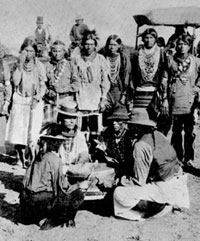
1892 Caddo dance party. Archives and Manuscripts Division,
Oklahoma Historical Society. |
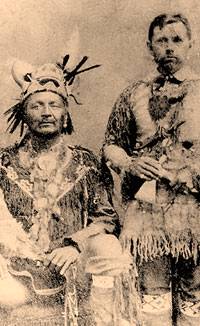
John Wilson and John Inkanish. Archives
and Manuscripts Division, Oklahoma Historical Society.
|
|
When the Ghost Dance was introduced to Caddos
in 1890, they adapted it to long held religious beliefs. They
had their own songs, and they had a pole. From the time of
the oldest ancestors, Caddos believed: Ah-ah-ha'-yo, father
above, hears our daily prayers; he provides and protects us;
there is a world beyond this one where our people gather after
leaving mother earth. The pole was carved from the heart of
a tall cedar tree. Painted black on one side, green on the
other, it was erected with the black side facing north, the
green side south. The leader stood on the invisible dividing
line at the west side of the pole. Facing east, he began the
first song telling that the feather signifying the right to
lead the Ghost Dance was given to seven men. Sometimes a person
in the dance-in-a-circle would fall in a trance. On waking
from a trance the person would tell of a vision and a new
song would be made. Sometimes healing miracles occurred.
The Ghost Dance began in January 1889, when
a Paiute man named Wavoka (Jack Wilson) had a vision during
a total eclipse of the sun. He foretold of a coming natural
disaster that would swallow up the Whites and allow Indians
to return to their lands and way of life. Wavoka's vision
spread quickly among diverse groups across the Plains and
beyond. John Moon-head Wilson, from the Caddo tribe, was one
of the charismatic leaders who helped spread the Ghost Dance
in 1890. By taking part in the five-day dance, Indians believed
that they would be reunited with their loved ones in the ghost
world. The speed and fervor with which the movement spread
sparked panic among white settlers and authorities and figured
prominently in the events that led to the massacre at Wounded
Knee.
Ghost dancing relieved uncertainty that clouded
the hopes of Caddo people. The songs were a form of communication
with the great Father Above. White people did not understand
and wanted to take it away. Failed attempts to gain permanent
title to the land they lived on made them apprehensive that
the "Great Father" in Washington would take it away
if he chose to do so.
|
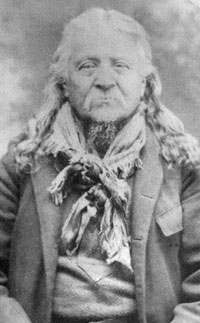
John Moon-Head Wilson, a Caddo man
who became one of the charismatic leaders of the Ghost
Dance movement in the early 1890s. Archives and Manuscripts
Division, Oklahoma Historical Society.
|
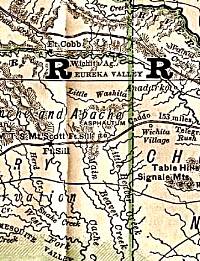
1884 map of Indian Territory showing the Wichita Agency
and area within which most Caddos settled. |
|
|
| |
White Bread, Chief of Caddos to his excellency The President
of the United States, February 3, 1888:
I am here only the representative of the Caddos—My
people live with the Wichitas, the Ionies [Hainai],
Anadarkoes, Tawaconies, Kechies and Southern Delawares. Each
one of these tribes once had a country and homes of their
own. Each tribe once had a country where their ancestors had
lived for generations and to which they were attached by ties
and associations as sacred and dear as those that cluster
in the memories and inspire the hearts of the white man for
his country and home. We have none now. . . .These things
have not happened to us because we were enemies of the white
man, and lived by rapine and bloodshed like many other tribes
of Red men. The story of our wrongs and sufferings is too
long to be told you now—I will not attempt it. . . .
We, the affiliated bands made war on no people, and lived
as best we could during the Civil War among the white people—After
the war, and after the Comanches, Apaches, and Kiowas had
made war upon the white people a treaty was made with them,
and our country, the home and country of the Wichitas for
generations back, was ceded to them, and the Wichitas and
affiliated bands, because of their peaceful lives and friendship
to the white man, and through their ignorance were not consulted,
and have been ignored and stuck away in a corner and allowed
to exist by sufferance.
These are simple truths only half told—I humbly ask
the great Father to take pity on his friendless and ignorant
children and have these things looked into, and if he finds
the story true that he will send for the Chiefs of the Affiliated
bands, with their interpreters, and council with them here,
to the end that we may have a country of our own, and if allowed
that that our present reservation, much of which is poor and
sterile, may be extended so that we can make a living for
ourselves, and raise our children in comfort and soon teach
them the white mans way—I am but an humble man, ignorant
and cannot talk as I would wish—and in order that the
great Father may know my thoughts I have spoken them and had
them interpreted to a friend and asked him to put them in
the white mans language for the great Father to read—I
hope our Father will give my words attention and some time
before long let us hear words of comfort that my people and
their friends may rejoice. I am done.
Punjo, Caddo interpreter
|
|
|
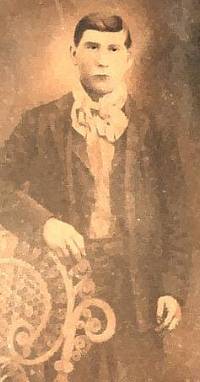
Bob Dunlap served as an interpreter for Whitebread, principal
chief 1902-1913. |
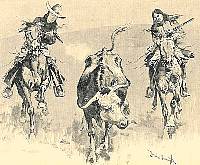
"Beef Issue at Anadarko" by Frederick Remmington.
From Davis, Richard Harding, 1903, The West From
a Car Window. Harper & Brothers.
|
|
Combining two Indian nations—Wichita and
Caddo—under an Agency titled Wichita and Affiliated Tribes
in 1859 has since tended to confuse anyone unfamiliar with
their separate histories. References to the Wichita Agency
and the Wichita Reservation compounded the confusion. It implies
the close association of unrelated members. The Caddo, the
Wichita, and Delaware were affiliated but Caddos, Anadarkos,
and Hainais were never affiliates, they were all of one blood.
Likewise, Wacos, Tawakonis and Keechis were never affiliates
of the Wichita, they were all of one blood.
In 1889 the federal government began appointing
commissions to "negotiate" with Indian tribes holding
large territories to break these up into small individual
allotments (160 or 80 acres) for each adult member of the
tribe and open up everything else to white settlers. In addition
to taking more Indian land, the process had the intended effect
of destroying tribal governments and forcing the integration
of Indians into American society. At the same time Indian
children were being separated from their parents and being
forced to attend boarding schools where they were taught in
English and forbidden to speak their native tongue.
The commission that dealt with Caddo and Wichita
lands was called the Cherokee or Jerome Commission, after
its chairman, David H. Jerome. The Jerome Commission, Presidential
appointees charged with the task of negotiating with the Wichitas
on the subject of accepting allotment of their lands in severalty,
actually had to deal with two individual Indian Nations—Wichita
and Caddo—each unwilling to accept the government's proposal.
Allotment in severalty meant giving each member possession
of a 160 or 80 acres, breaking up Indian Nations, and opening
unalloted land for white settlement.
Chairman Jerome opened the council in May of
1891 with words that echoed those heard by Caddos before signing
the treaty that ceded their Louisiana homeland to the U.S.
in 1835. Jerome's statement, another commissioner's remarks
and the response of Caddo Jake, Caddo principal leader, are
in the record of the proceedings.
|
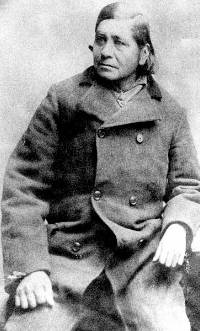
Chief Whitebread, Caddo Principal leader (1902-1913),
had apprenticed under Caddo Jake. |
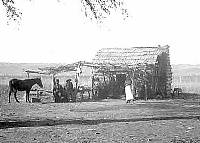
1890s photograph of Caddo house on
Oklahoma prairie entitled "Group of Four near Judge
Georg Parton's House." Photo taken by James Mooney
before 1896. National Anthropological Archives.
|
|
|
| |
You can get a living better than you do now, and that
is what we have come to tell you. The Government has a plan,
which if you will adopt and try your best to live up to, will
give you more comforts and better living to you, and your
families, than you have ever had before. . . The Government
of the United States is the only friend and the best friend
that the Indian has, and it is the Government of the United
States that sends this food here to feed these Indians every
day.
Commissioner Chair, David Jerome
Wichitas have "more land than you can use and more
than anybody in this nation can use and that is the reason
we are come to ask you to take a less piece."
Warren G Sayre, member of the Jerome Commission
The Government should give us time to send our children
to school and educate them and then it is time to send this
Commission. . .if "pity" were had on
the Indians, the Commission would "return to Washington"
and this time would be allowed. [Caddo Jake] said plainly
that the Wichitas were not able to take land in allotment,
were not able to take care of it, and that they wanted to
return to their farm work and "not sit around here
and talk for several days." The Wichitas had been
"quite a little while . . . fixing their country"
and felt that it was their own; moreover they preferred
to talk about "greater claims" and "old
claims" the Wichitas had against the Government,
as to how their lands were reduced to "this little
strip of land north of the Washita." They said their
reservation was "about the right size" and
they would like to keep the land for the next generation.
"Can you tell us how many children are coming?"
Caddo Jake, in Council with the Jerome Commission,
Anadarko, May 11, 1891
|
|
|
| |
The government's will could be stalled, but
it would prevail. The Caddo Nation would falter, but it would
survive. Strength lay in the people's ability to hold on to
distinctive Caddo traditions that bound them while throwing
away old ways that no longer worked.
|
|
|










 The Riverside Indian School across the Washita River
from Anadarko, Oklahoma grew from the first Wichita
Agency school that employed Tomas C. Battey as teacher
in 1871. 1899 photograph by Annette Ross Hume. Western
History Collections, University of Oklahoma.
The Riverside Indian School across the Washita River
from Anadarko, Oklahoma grew from the first Wichita
Agency school that employed Tomas C. Battey as teacher
in 1871. 1899 photograph by Annette Ross Hume. Western
History Collections, University of Oklahoma.










